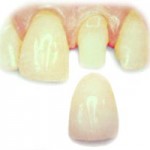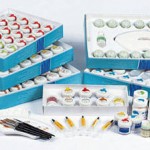A dental crown is prostheses that replicates the features of a tooth that it is replacing, and will be fixed onto the tooth after the tooth it is replacing has been cut down. There are a few ways to classify a dental crown, and if it is classified according to its composition, there are three types: porcelain crown, porcelain fused metal (PFM) crown, and metal crown.
What is porcelain?

The porcelain crown is able to closely mimic the adjacent natural teeth
Porcelain, or also known as fused ceramics, is ceramics added with extra materials such as silica and feldspar for translucency and extra strength. Ceramic is mainly made from clay, and is opaque, relatively weak, and porous, which makes it unsuitable for dental applications. Fused ceramics has long been used in the art field because of its ability to be produced in any shade desired, and also its translucent effect unlike other materials. Therefore, it is not surprising that dentistry has turned to porcelain for construction of bridges, crowns, onlays, and much more.
What is the composition of porcelain?
There are two types of porcelain used in dentistry – high-fusing dental, and low-fusing dental, with low-fusing dental being used more often. High fusing dental porcelain fuses around 13000C to 14000C, while low fusing dental porcelain fuses around 8500C to 11000C.
The contents of high fusing dental porcelain are as below:
Clay 4%
Silica 15%
Feldspar 80%
While the contents of low fusing dental porcelain are as below:
Silica 25%
Feldspar 80%
Glass 15%
Clay is also known as kaolin, which is a hydrated aluminosilicate, while feldspar is a mixture of potassium and sodium aluminosilicate. Feldspar acts as a flux or a binder and is the lowest fusing component. Because of this, it melts and flows during firing, uniting other components into a single solid mass. The fusion temperature of feldspar may be even further lowered by adding other low fusing fluxes such as borax.
The given components of porcelain are the general guidelines for dental prostheses construction. However, there is a trend presently to decrease the proportions of clay, while increasing the feldspar content to improve the translucency. But to achieve this, highly controlled firing times and temperatures are needed.
The powders supplied to the technicians or the dentists are not just a combination of the various components as listed above. The components are first mixed together, and then fused together to form a frit. The frit is then broken up by dropping it while it is hot into cold water, and then grounding it into fine powder. During the fusion process, the flux will react with the outer layers of kaolin, silica and glass, partially combining them together. When the technician or the dentist fuses the porcelain powder, the flux is simply being remelt without causing any significant reaction between the flux and the other components.
Metal oxides are often added into porcelain powders as pigments for them to be tooth coloured, as metal oxides are stable during fusion temperature. This gives porcelain an advantage over other materials as they can match the shade of the adjacent tooth closely and gives a realistic appearance.
Some feldspathic porcelain are supplied as opalescent porcelains, which contains small amounts of metallic oxides. These metallic oxides have high refractive index and particle size near to that of the wavelength of light, therefore, they can give out a light scattering effect. This mimics the natural teeth, which is also display some degree of opalescence, and further improves the aesthetics of the fabricated prostheses. Uranium used to be added into porcelain powders to stimulate tooth fluorescence as seen in natural teeth. It is discontinued now because of its obvious hazard to health and also it gives an unnatural appearance and it is unnecessary.
After the prostheses has been fabricated, a smooth surface can be achieved by glazing it with a low fusing, transparent glass. This also gives the prostheses a more translucent appearance, making it more aesthetically superior. Another method of obtaining a smooth surface finish is by carefully controlling the furnace temperature. The surface of the normal porcelain will flow and glaze with only a slight rounding of the contours of the prostheses. However, the disadvantage of this method is that any overheating will cause gross distortions to the prostheses, rendering it useless.
Porcelain is undeniably a very useful and suitable material for the time being to fabricate dental prostheses because of its ability to mimic natural tooth. However, it is brittle and prone to fracture when submitted to occlusal loads repeatedly. Therefore, there has been various methods to strengthen porcelain, such as adding aluminum into porcelain to produce aluminous porcelain and sintered alumina core ceramics.

